Menu
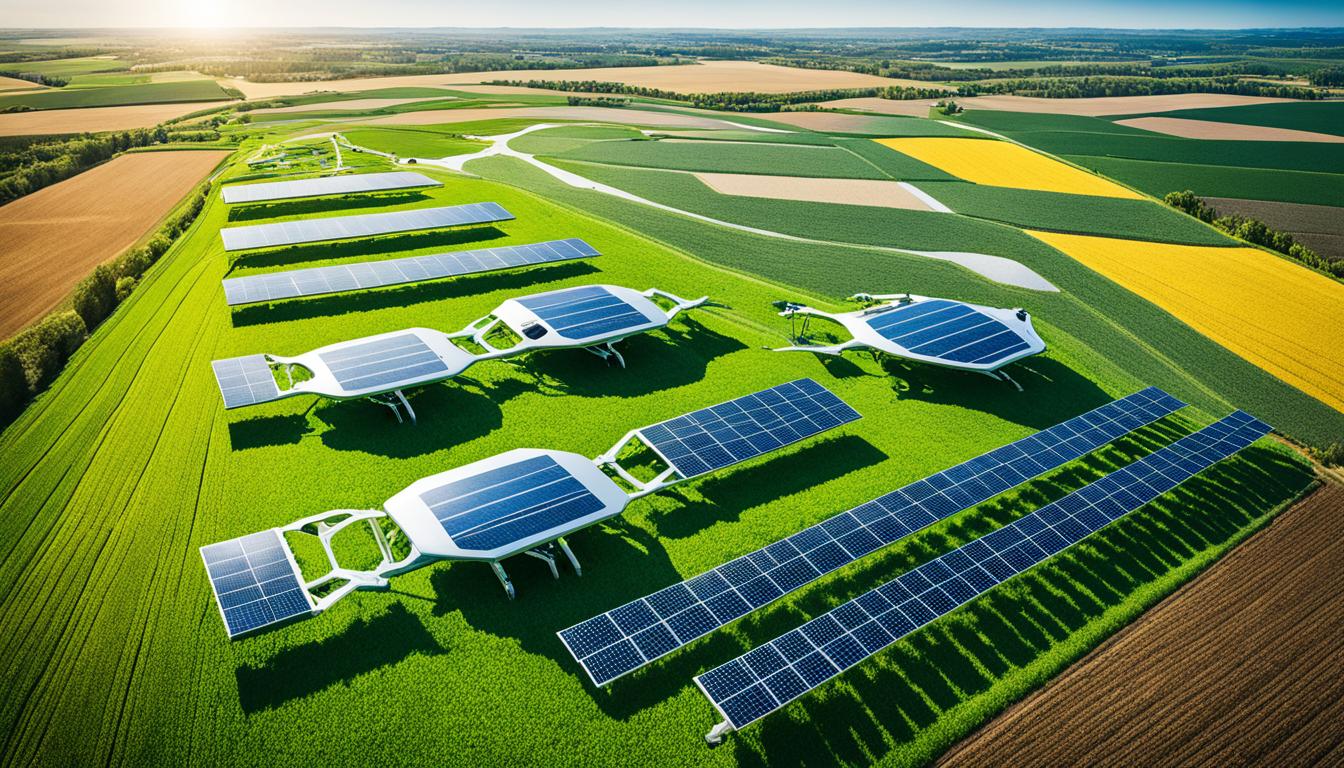
Did you know the global autonomous agriculture industry could reach over $95 billion by 2027? This large number shows big changes in farming thanks to new technology. Smart machines for planting use artificial intelligence. This helps place seeds in the best spots. Also, spraying machines, controlled by drones, are more efficient and planet-friendly.
In China, companies are at the forefront of this farming revolution. They heavily invest in developing new technology. For instance, robotic harvesters are changing how farms work. They cut down on manual work and increase efficiency. Another example is soil management tools. These have sensors to measure soil and help with planting in a way that doesn’t harm the land. All these advances are not just about doing more. They are about doing it in a way that’s good for the planet, making these tools key for the future of farming.
The world’s growing population needs more food, demanding innovation in agriculture. Old farming ways can’t keep up, pushing for cutting-edge farming equipment. The World Government Summit report warns about the shrinking global GDP from agriculture. It also alerts us to the food scarcity crisis. This points to the urgent need for advanced tech in farming to boost production and protect our planet.
Today, farming must be smarter to feed more people. New electrification tech is making huge strides, like electric drives. These are proving better than traditional engines and hydraulics, offering high power at low speeds. John Deere’s electric compact tractor is a fine example. It runs quietly, emits no fumes, and has low maintenance costs. Such innovations are key to the bright future of farming.
Technology is changing farming fast. The VoloDrone from John Deere and Volocopter can quickly cover large farmlands, offering hands-off operation for better crop care. Then there’s AutoTrac and Integrated Combine Adjust, making machines smarter with real-time updates. This way, farmers become more efficient and effective.
John Deere’s CommandCab mixes AI and weather data for smarter farming decisions. There’s also an autonomous drone sprayer that targets weeds with precision, cutting down on pesticide waste. This wave of technology and clever ideas is ushering in a new golden era for farming. It promises to be safer, more productive, and kinder to our planet.
Looking at global trends shows us how crucial they are for agriculture sustainability. The world is gearing up to handle a population of 10 billion by 2050. This means our farms need to produce more food in a sustainable way.
The world’s population is growing fast, and we’ll need 68% more food by 2050. To meet this demand, we have to find new ways to farm efficiently and sustainably. Things like precision farming help us use water and chemicals better, reducing waste.
Natural resources like water and land are running low. And current farming practices are a big pollution source. One solution could be vertical farming, which uses less space but can produce a lot more food. This could help us preserve resources better.
“Plant-based diets are suggested as the most impactful way for individuals to reduce environmental impact.”
Climate change is messing with our weather and hurting crop yields. Farmers need to use smarter ways to grow crops. IoT devices and AI can help by keeping track of the soil and plants, making farming more efficient.
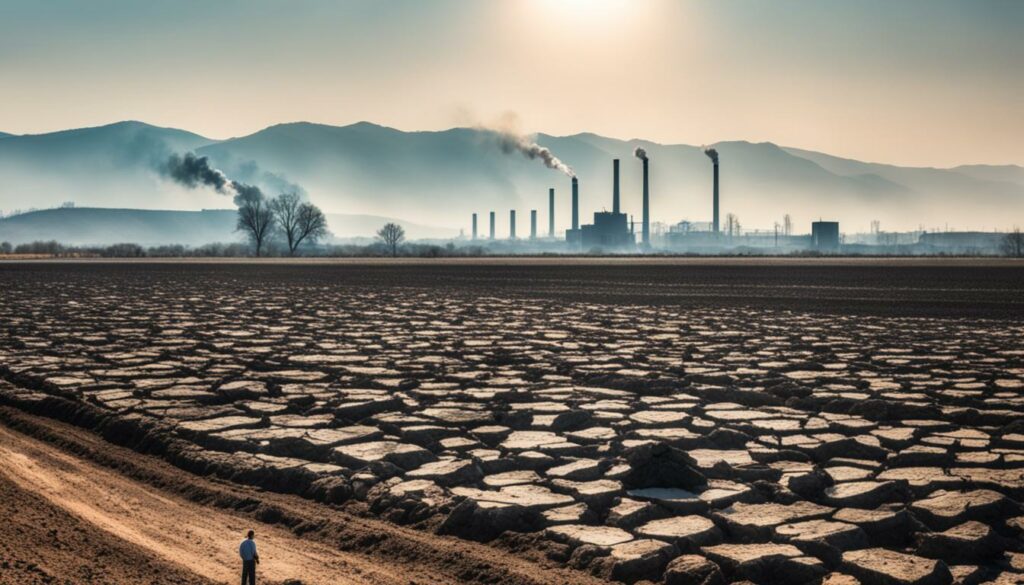
Too much food is being thrown away, causing big problems. Finding solutions is key. One answer is to buy food from nearby to cut down on long supply chains. People are asking for food that’s not only tasty but also good for the planet.
| Trend | Impact on Agriculture | Solution |
|---|---|---|
| Population Growth | Increased demand for food production | Innovative farming technologies |
| Natural Resource Scarcity | Higher emissions from agriculture | Adoption of vertical farming |
| Climate Change | Altered weather patterns affecting crop yields | Implementation of IoT and AI technologies |
| Food Waste | Significant economic and environmental impacts | Local sourcing and supply chain resilience |
The trends above are changing agriculture in big ways. We must keep coming up with new ideas. This way, we can feed everyone while taking care of our planet and fighting climate change.
The use of advanced robotics in farming is a big step forward. It brings more efficiency and accuracy to our fields.
Automated harvesting is changing how we farm. It cuts the need for lots of workers and boosts how much we produce. Tortuga AgTech‘s robots can pick fruit with 98 percent accuracy under the watch of just one person. Harvest CROO‘s robot can pick a strawberry plant in 8 seconds and jump to the next in 1.5 seconds.
Next, FFRobotics‘ fruit harvester works ten times faster than a human. This speeds up picking a lot. Not only that, but it picks with great care, making sure no fruit gets wasted.
Killing weeds with robots is a new and better way in farming. The Carbon Robotics‘ LaserWeeder uses smart eyes to find and zap weeds without hurting the crops. This means less need for harmful chemicals.
Naio Technologies and Nexus Robotics are leaders in making robots that weed in fields and vineyards. Nexus Robotics’ R2Weed2 robot can tell the difference between weeds and crops, helping farmers learn more about their fields.
Scythe Robotics‘ mower, the M.52, is super smart. It has a dozen sensors and advanced smarts for perfect navigation and weed cutting. All these robots make farming greener and more efficient, protecting our world while growing our food.
By using these robots, farming is becoming more advanced but also kinder to our earth. They’re making the way we grow food better in every way.
| Company | Robot | Functionality | Efficiency |
|---|---|---|---|
| Tortuga AgTech | Fruit Picking Robot | 98% accuracy in picking fruit | Requires supervision of a single person |
| Harvest CROO | Strawberry-Harvesting Robot | Picks a plant in 8 seconds | Shifts to the next in 1.5 seconds |
| FFRobotics | Robotic Fruit Harvester | 10 times faster than human pickers | Expedites the harvesting process |
| Carbon Robotics | LaserWeeder | Differentiates between crops and weeds | AI and computer vision technology |
| Scythe Robotics | M.52 Mower | Advanced navigation and weed control | Equipped with 12 sensors for 360-degree perception |
| Naio Technologies | Weeding Robots | Weeds vegetable fields and vineyards | Automates labor-intensive tasks |
| Nexus Robotics | R2Weed2 Robot | AI differentiates between weeds and crops | Assists in weed control and data collection |
Precision agriculture involves using data to change farming for the better. It uses the latest technology and analytics to improve crop yields and save resources. In the US, over half the farmland uses technology like automated guidance. This shows how big of a change precision agriculture is making.
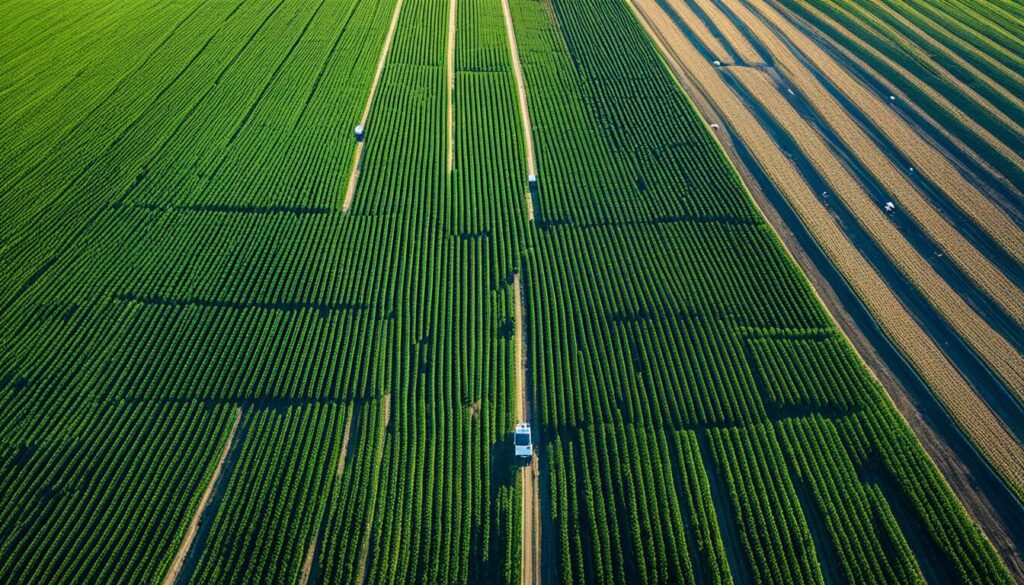
New tech like GPS, drones, and yield monitors have changed how farmers gather information. They check on the crops, find pests, and track how much is produced. Variable-rate technology allows for smarter spreading of pesticides and fertilisers. It matches the needs of the soil and land, which makes crops healthier and more productive.
Farmers also use software with AI to get detailed maps and financial advice. This helps them make choices backed by solid evidence.
Precision agriculture is all about using resources better. Machines that run on their own and robots cut down on mistakes and use less of everything. Sensors in the soil and on plants give constant updates on what they need. This makes it possible to adjust care very precisely.
Today, seeing how crops and soil are doing is as easy as looking at satellite photos. This quick information means smarter choices can be made fast.
| Technology | Function | Benefit |
|---|---|---|
| GPS Guidance Systems | Navigation & Field Mapping | Increases Efficiency |
| Drones | Crop Health Monitoring | Reduces Waste |
| Yield Monitors | Data Collection | Better Decision-Making |
| Variable-Rate Technology (VRT) | Resource Distribution | Enhances Crop Health |
In 2022, the precision agriculture market was worth USD 9.4 billion. Experts predict it will keep growing. This trend shows that more and more farmers see the value of these precision tools for better yields and smarter farming. Even though it can be costly and need a lot of know-how, there are ways to help like funding, teaching, and simpler tools.
Artificial intelligence is changing farming for the better. It brings in a new era of efficiency. AI and machine learning are key to tackling the world’s food challenges as the population grows.
They help farmers produce more crops to meet everyone’s needs. This technology is vital for the future of agriculture.
Predictive analytics is crucial in managing crops. It uses data and shaping accurate forecasts for farmers. With AI, they can meet market demands, predict prices, and find the best times for activities like planting.
This approach boosts productivity and uses resources better. It’s a smart way to farm for the future.
Keeping soil healthy is key to sustainable farming. AI now checks soil conditions in real-time. It gives insights on soil moisture, nutrients, and pH levels.
NatureFresh Farms in Ontario and Ohio is using AI for this. They have 2,500 sensors in their greenhouses. This shows how AI is transforming soil health monitoring for better crop growth.
AI is also making irrigation smarter. It analyses the environment and crop needs to use water better. This precision saves water and supports sustainable farming.
Thanks to AI, farmers can produce more with less water. This helps in the effort to save natural resources.
| AI Application | Benefit |
|---|---|
| Predictive Analytics | Forecast prices, sowing, and harvesting times |
| Soil Health Monitoring | Real-time data on soil moisture, nutrients, and pH |
| Smart Irrigation Systems | Optimised water usage and resource conservation |
China’s new farming machines are changing farming worldwide. They’ve put a lot into research and development. Now, their machines can use data and the Internet of Things to make smart decisions. This boosts how much food we get and helps the planet.

Smart planting machines in China are making planting smarter. They use AI to put seeds in the best place. This makes more food and cuts down waste, which is good for farmers.
In China, they’re using drones to spray crops. This lets them use less chemicals and spray more land. It’s better for the earth. Plus, the drones make sure only the plants that need it get sprayed.
Robots are now harvesting crops in China. They work all the time and need less people. These robots pick crops precisely and fast. This keeps farming up to date.
| Type of Machinery | Key Benefits |
|---|---|
| Smart Planting Machines | Increased seed germination rates, uniform crop growth |
| Advanced Spraying Equipment | Reduced chemical usage, increased coverage |
| Robotic Harvesters | Improved harvest efficiency, reduced manual labour |
China’s new farm tech will soon use more advanced tools like learning machines and blockchain. This will make farming even better and good for the earth. Chinese farming equipment is becoming more famous worldwide. It helps farmers everywhere.
Smart agricultural devices are changing farming for the better. They use the latest technology to boost productivity. With IoT, these devices link up with other tools on the farm. This connection makes everything work smoother.
IoT in farming makes things much easier. It lets devices share data instantly. This means machinery can work better, helping with tasks like checking crops and soil. Such technology helps farmers manage resources well, leading to better harvests.
Keeping an eye on the farm in real time is key. Devices with sensors send data straight to the cloud. This data includes details about the soil, weather, and how the crops are doing. With this info right away, farmers can tackle problems quickly and keep things growing well.
And there’s more to come with autonomous farming. Drones and UAVs are starting to do farming jobs by themselves. They can check on crops, plant seeds, and spray fields, cutting costs and making things safer for farmers.
To really see how smart devices are improving farming, look at the points below:
| Feature | Benefit |
|---|---|
| IoT Integration | Real-time data and insights for informed decision-making |
| Real-Time Monitoring | Instantaneous response to emerging issues |
| Autonomous Machinery | Reduced labour costs and continuous operations |
| Precision Agriculture | Maximisation of production while conserving resources |
| Drones and UAVs | Efficient crop monitoring and health evaluation |
Sustainable farm technology is leading us towards a greener future in agriculture. It focusses on saving resources and using renewable energy. The need to cut down on farming’s impact on the environment has grown. This has pushed for the use of more eco-friendly methods.
Resource conservation is key in sustainable farming. Smart techniques, like the zero emission tractor, save a lot of energy. It can mow over 10,000 m² of lawn on just one charge. Another cool tool is the eAutoPowr system. It can give up to 100kW of power for other uses, saving money when mixing slurry by up to 25%. Also, the new autonomous sprayer is great for the soil. It’s light and has a 560-litre tank. It means less damage to the soil after it rains.
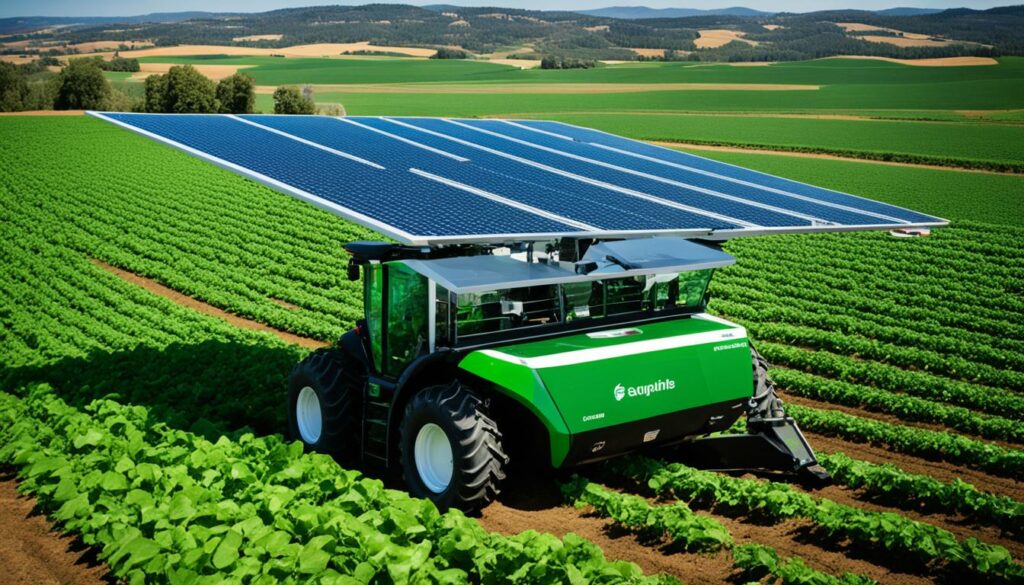
John Deere has come up with S700 combines that adjust themselves in real-time. This saves resources while keeping up the good work. Their autonomous tractor can hold from 5 to 15 tonnes. It helps prevent too much pressure on the soil and can make up to 500 kW. This shows how clever machines help save resources and keep productivity high.
Using renewable energy is a big part of making farming sustainable. Large drones like the VoloDrone cover a lot of ground quickly. They’re powered by renewable energy. Semi-autonomous tractors that spray crops have cut costs by over 30%. They use energy very well.
Autonomous drone sprayers are great for applying pesticides accurately. This means using less chemicals and getting healthier crops. The See & Spray system is smart. It can tell weeds from the crops as it sprays. This kind of tech shows how renewable energy boosts both farming’s efficiency and its eco-friendliness.
| Sustainable Innovation | Feature | Impact |
|---|---|---|
| Zero Emission Tractor | 4.5-hour battery life | Mows over 10,000 m² per charge |
| eAutoPowr Transmission | 100kW power supply | Reduces slurry incorporation costs by 25% |
| VoloDrone | 18 rotors | Covers up to 6ha/hr |
| See & Spray Technology | 20 images per second | Specific weed treatment |
| Autonomous Sprayer | 560-litre tank, lightweight | Minimises soil compaction |
| Autonomous Tractor | 500 kW output | Flexible ballasting reduces soil compaction |
Embracing sustainable farming and renewable energy is crucial for a green future. These technologies solve environmental issues and boost farming’s performance and efficiency. They’re key to farming’s long-term success.
Next-generation farming tools bring many benefits. They save a lot of money, make farms more productive, and help protect the environment.
Future farming tools, like AI cultivators, work all day long. This cuts down on manual work, saving money. They also boost how much work a farm can do since they never stop working.
FarmWise is one example. They use smart technology to weed accurately. This saves money. Also, a single strawberry picking robot can do the work of 30 people in just three days. This shows how the future of farming is changing.
At a bigger level, the global greenhouse industry is also joining the tech revolution. With things like LED lights and smart controls, farms are getting more efficient. This means more produce for the same effort. The use of smart technologies in farming is growing. By 2025, it could be worth over $43 billion. This shows the future of farming is all about using data wisely.
Next-gen farming is good for the planet, too. Vertical farms use much less water than traditional ones. This helps save water, an essential resource. By using smart tech, farms can also cut down on pesticides a lot. This way, farming has less impact on the environment.
To meet the food needs of the future, farming must grow by 70%. This growth cannot harm the planet. So, using the latest tech in farming is really important for our future.
Technologies like blockchain make sure our food is safe and its path is clear. This reduces food mistakes, making food safer. AI tools in farming help keep track of food safety and predict how much food we will have. They can even guess how much food will cost. This helps farmers make smarter choices.
With the world’s population growing, and people wanting different foods, farming faces big challenges. The future of farming is bright, though. It can save money, produce more food, and protect the planet. So, the future of farming is a big step forward in how we grow food.
Autonomous farming is changing how we grow food with the help of artificial intelligence and machine learning. Now, tasks like planting and harvesting can happen on their own. This shift is taking agriculture to a new level of efficiency and productivity like never before.
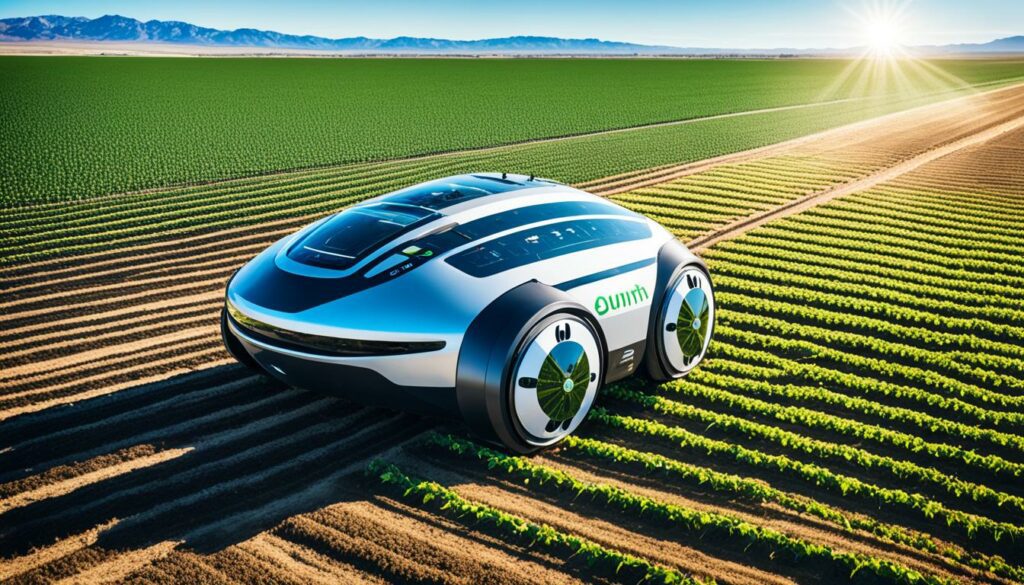
Driverless tractors and combines are leading the way in autonomous farming. Companies such as TYM have started making self-driving tractors since 2013. In 2021, their self-driving tractor in Korea showed just how precise these machines can be.
The T130 model can remember the places it has worked before. This means there’s no need to keep setting it up. It works all day and night, making farming more efficient and saving on labour costs.
Autonomous tractors help farms to be bigger without needing lots of people to work them. These machines are also designed with the latest safety features to avoid accidents. This makes the farm a safer place for workers.
Automated livestock management is key in autonomous farming too. It takes good care of the animals by monitoring them all the time. This includes feeding and milking the animals automatically.
These automatic systems save money by cutting out the cost of hiring people. They also make the farm a nicer place to work as there’s less need for hard, manual labour. And, they keep workers away from dangerous tasks.
| Benefits | Impact on Farming |
|---|---|
| Increased Efficiency | Tasks are completed autonomously, reducing downtime and improving productivity. |
| Cost Savings | Reduction in labour costs and elimination of related expenses. |
| Environmental Sustainability | Optimised use of resources and reduction of harmful chemicals. |
| Enhanced Safety | Minimisation of manual labour and improved working conditions. |
Urban areas are growing, and that means less space for traditional farms. Vertical farming is changing this. It stacks plants in tall buildings. This makes the most of space and fits well with cities.
Vertical farms are at the heart of innovations in urban agriculture. They use smart planting methods instead of soil. These methods use less water and give nutrients straight to the plants. Also, they use LED lights that are great at helping plants grow.
These farms keep a close eye on things like light, temperature, and food for the plants. Watching these things carefully helps the farms produce a lot of food, even in small spaces. This means they can grow food all year round.
Vertical farming is a game-changer for food security. It can grow more food in less space than traditional farms. It uses less water because of its smart planting methods.
This kind of farming doesn’t need big, polluting machines. So, it helps the planet by reducing air pollution. The food from these farms is also safer because it uses fewer chemicals. Plus, farms in cities mean food doesn’t have to travel far to reach you.
| Factors | Traditional Agriculture | Vertical Farming |
|---|---|---|
| Space Utilisation | Horizontal | Vertical |
| Water Usage | High | Low |
| Yield Per Square Foot | Lower | Higher |
| Seasonal Limitation | Yes | No |
| Urban Compatibility | Low | High |
Setting up a vertical farm can cost a bit at first. But new tech is making it better and cheaper all the time. This way of farming saves space and is key to making sure we have enough food in cities.
Using high-tech tools in farming faces many obstacles. It costs a lot to get started. This makes it hard for many farmers to begin. Also, the high cost is a big hurdle.
The world’s economy is also not helping. To push these new farming tools ahead, we need new ways to get money. This will help more farmers join in.
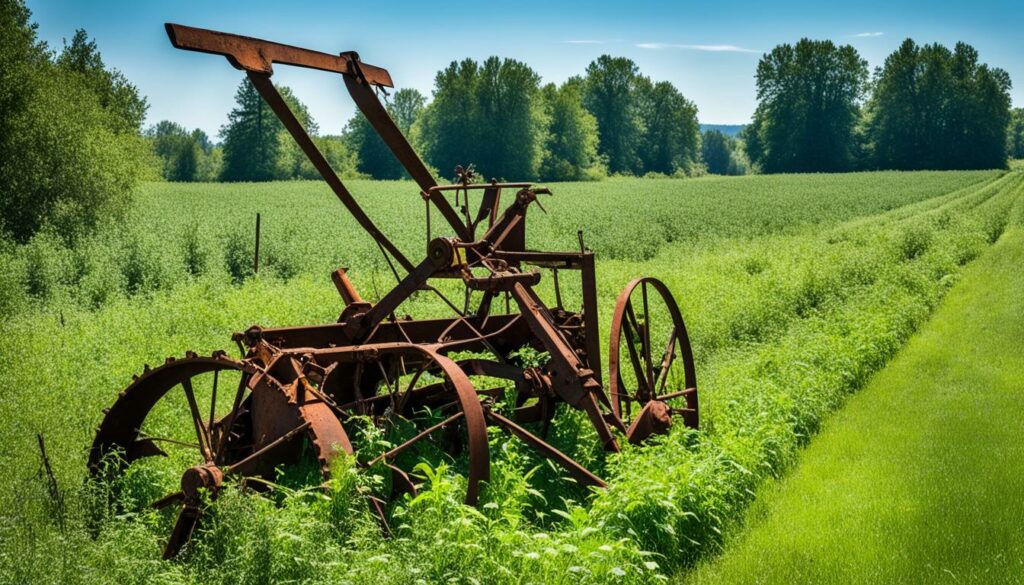
Getting the latest farming tools is not cheap. Machines that work on their own can do a lot. Yet, they need a big investment first.
Many farmers can’t afford these costs. Even though the tools can save money in the long run, the starting cost is just too high.
Support for farming investments is key. Leaders and those in the field must work together. They need to find ways to help farmers afford the new technology.
Grants from the government and help from private investors are crucial. They make it easier for more farmers to get these tools.
Using new tools means farmers need new skills. Training is important. It makes sure they know how to use the tools well.
New smart tools can boost harvests and improve food quality. But to get these benefits, farmers must know the latest about technology. They need to learn how to use everything from drones to precision farming.
This is why teaching programmes are vital. They help farmers keep up with the latest in farming. They focus on the tech needed in today’s farming world.
| Challenges | Opportunities |
|---|---|
| High initial costs | Government grants and subsidies |
| Lack of technical skills | Training and development programs |
| Economic barriers | Private investments |
Dealing with these issues by investing more in farming and training will lead to better farming. It will mean a more effective, green, and tech-savvy farming sector.
The advent of future farming equipment is undeniably setting the stage for an agricultural landscape revolution. This revolution is powered by China’s remarkable growth in agricultural machinery. A major reason behind this growth is China’s commitment to research and development.
This new equipment uses tech like AI, drones, and IoT to boost farming. Thanks to smart machines and tools, farm output has soared. Farmers benefit from smart planting, robotic harvesters, and soil tools, which make work easier.
Chinese equipment also helps the planet and saves money. Their spraying gear targets treatments precisely, saving resources. Robotic harvesters mean less work and more efficient farming, making a big difference.
Chinese tools for managing soil improve soil health and crop growth. The world’s farmers are turning to Chinese machines because they’re affordable and high-quality. This shows how valued these tools are globally.
Data shows that technology in Chinese machines is changing how we farm. It’s helping us use resources better and cut waste, which is good for the planet. There’s real proof that these new ways of farming are sustainable in the long run.
| Technology | Impact |
|---|---|
| Artificial Intelligence | Enhanced productivity and efficiency |
| Drone Technology | Precise targeting and resource conservation |
| Robotic Harvesters | Efficiency gains and labour reduction |
| Soil Management Tools | Improved soil health and crop yields |
| IoT Integration | Optimised farming practices and environmental benefits |
In short, future farming equipment is leading to big changes in farming. It’s making farming more productive, sustainable, and high-tech.
The era of smart farming is here because we need to feed a growing global population. By 2050, the world could have 9 billion people. New farming methods are vital to meet this demand. They let us grow more food using less land, water, and energy.
These new ways include automated farming, which combines sensors, software, and machines. This technology has changed farming. It lets us be more effective, making it easier to farm and grow more food.
With the help of AI, farmers can produce more crops, use less water, and save money. This new approach is based on detailed data and modern tech, like IoT and machine learning. Companies like John Deere help farmers by giving them tips and real-time data, making their work easier.
Farming machines can work by themselves, cutting labour costs and making farming round the clock. They use drones and sensors to adjust to the needs of each crop. This not only helps grow better and more food, but it is also better for the planet. It helps save resources and reduces the need for harmful chemicals.
In short, the future of farming relies on smart technology and sustainable methods. This mix helps us answer the future’s food needs, in a way that looks after the Earth, too. What we see happening now is key to a strong and lasting future for farming all over the world.
Future farming equipment includes new tech and techniques. They help us meet the demand for food and protect the environment. This gear aims to make farming more efficient, green, and productive.
Innovation is vital with the world’s growing population. By 2050, we’ll have around 10 billion people to feed. New farming tech boosts how much food we can grow, keeps us safe, and is kind to the earth.
Different trends impact farming’s ability to stay green. More people need food as climate change affects the earth. New, green tech and machines can help farmers deal with these growing challenges.
Advanced robots make farming more precise and efficient. They can harvest, weed, and control pests without as much human help. This saves labour, uses fewer chemicals, and is better for the planet.
Precision farming uses AI to gather and study data. This helps farmers use their resources better and grow more food. It’s about making smart choices based on real facts.
AI and machine learning make farming more predictive and efficient. They’re used in things like looking after crops, checking soil health, and smart watering. These tools help save resources and make farming easier.
China’s making big changes in farming with smart machines. They use drones to plant seeds, spray fields, and harvest crops. This tech boosts how much is done, using less human work.
Smart devices in farming use the internet to connect everything. They help keep an eye on the farm all the time and make decisions based on up-to-the-minute data. This leads to better farming, less waste, and smarter choices.
Green farming tech saves resources and looks after the planet. Things like AI and automation are turning farming into an eco-friendly activity. They’re the key to a future where we can grow enough food without harming the earth.
New farming tools save money and help the planet. Thanks to AI and precision farming, we can now grow more with less. It’s a win for efficiency and nature.
Autonomous farming includes machines that drive themselves, like tractors. It also has tools to care for animals without constant human oversight. These smart systems make farming more precise and efficient, all with less effort from people.
Vertical farming uses less space and resources but grows a lot of food. It’s great for places where land is hard to find, like cities. This method helps keep food production high without using up all the land.
Moving to advanced tools can be costly and need big investments. Farmers also need to learn new skills to use the tech well. Overcoming these hurdles means we can farm better and in a way that’s good for the planet.